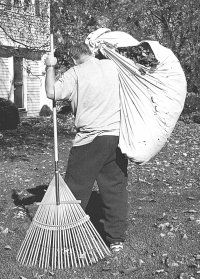| Castle Valley residents should exercise caution when working outdoors or completing household chores in rodent infested areas. The state department of health has confirmed three hantavirus cases in Utah during the current year. |
Since surveillance efforts started in 1993, 21 cases of hantavirus pulmonary syndrome have been identified in Utah.
The illnesses resulted in a 33 percent case fatality rate, including two Carbon County residents.
In Utah, 67 percent of the patients have been male and 33 percent female. The mean age is 35, but ranges from 19 to 67 years. Hantavirus cases have been identified in nine Utah counties.
According toUtah Department of Health data, 313 hantavirus cases were reported in the United States as of April, with a 37 percent fatality rate.
Of the confirmed hantavirus patients, 60 percent were male and 40 percent female. The mean age nationwide is 37 years, with a range of 10 to 75 years.
Three hantavirus cases have occurred in Utah in 2002, indicated the health department.
The first victim, a 25-year-old Wayne County resident, was hospitalized from April 26 to May 24.
Initial interviews with family and friends confirmed the patient had history of camping and working in the outdoors. No specific rodent exposures were determined.
The second incident involved a 22-year-old Salt Lake County resident. The patient was hospitalized from May 10 to May 17.
The third hantavirus case in 2002 involved an individual from Iron County who was hospitalized on June 2.
The illness developed rapidly and claimed the life of the Iron County patient.
Due to the rapid onset of shock and respiratory failure in hantavirus patients, early recognition of the illness is critical in reducing the risk of mortality.
Hantavirus begins four days to six weeks after exposure to infected rodents or droppings although not all infected patients give a history of rodent exposure, explained the health department.
All patients experience a prodromal phase with fever, chills and pain in muscles, persisting for one to seven days before progression to the cardiopulmonary phase.
Pain in the legs and back can be severe during the preliminary stages of hantavirus, explained the public health department. Many patients also experience nausea, vomiting and diarrhea.
Cough and upper respiratory symptoms are not present in the initial preliminary phase, but develop hours before the onset of the pulmonary edema and cardiogenic shock.
It is difficult to clinically distinguish between the initial stages of hantavirus and many viral or bacterial infections, pointed out the health department. Therefore, the use of blood tests, including platelet counts, is recommended. All hantavirus cases eventually have low platelet counts.
The transition from the early stages of hantavirus to respiratory failure occurs four to 12 hours after onset of the cough and shortness of breath. All patients should be under respiratory isolation until the diagnosis is confirmed by testing.
The following are clues physicians use for finding the rare hantavirus case among the thousands of flu patients visiting doctor offices annually:
•Flu syndromes present symptoms without rhinorhea, otitis, sinusitis or congestion.
•Nausea, vomiting, diarrhea and abdominal pain are often severe in hantavirus patients.
•The cough does not start on the first day of the symptoms, but generally after two or more days and heralds the onset of pulmonary edema.
•A rapidly falling platelet count helps distinguish hantavirus from benign illnesses.
Hantavirus has emerged as a new viral disease communicable to man from an animal since identified in spring 1993 in the Four Corners region.
But retrospective case-finding has indicated that hantavirus is not new to the United States, indicated the health department.
In fact, the retrospective diagnosis of a 1959 Utah case reveals that human infections resulting in hantavirus pulmonary syndrome went unrecognized until May 1993.
The human-rodent interaction along with the identification and characterization of environmental and ecologic factors as well as the influence on the density of rodent populations are critical to understanding the epidemiology of hantavirus pulmonary syndrome.
Apparently, epidemiology of hantavirus closely parallels the ecology of its rodent hosts, pointed out the health department. The majority of diagnosed patients have had clearly identifiable domestic contact, recreational or occupational exposure to rodents of which the majority are the deer mouse.
The deer mouse is the primary host for hantavirus and the most abundant rodent in North America.
The most effective method to prevent infection with hantavirus is to avoid contact with any rodent species, emphasized the department of health.
Activities Castle Valley residents should avoid include using rodent inhabited buildings, cleaning barns or outbuildings infested with rodents and disturbing rodent nests and burrows while hiking or camping.
When eliminating rodent infestation sites inside dwellings or outbuildings, Castle Valley residents should exercise the following precautionary measures:
•Seal all openings into the home that are greater than one-fourth inch. Mice can squeeze down to larger size holes and enter buildings.
•Keep all weeds, woodpiles and garbage at least 100 feet from homes.
•Keep all food, including pet food, in rodent proof containers.
•Keep kitchens and food preparation areas clean.
•When handling rodents that have been trapped, remember to wear gloves.
•Use snap traps to trap and kill mice.
•Spray mice and trap with disinfectant.
•Place the rodent carcass and infested materials inside a double plastic bag for disposal.
•Leave several baited spring loaded traps inside the house at all times.
•Wear rubber gloves while cleaning up mice droppings and nests.
•Air out area for 30 minutes.
•Do not create dust by sweeping or vacuuming.
•Spray rodent droppings and nests with disinfectant.
•Place rodent droppings, nests, and other contaminated items in double bag for disposal.
•Wash gloved hands in a household disinfectant and then in soap and water.
•Wash bare hands after removing gloves.

